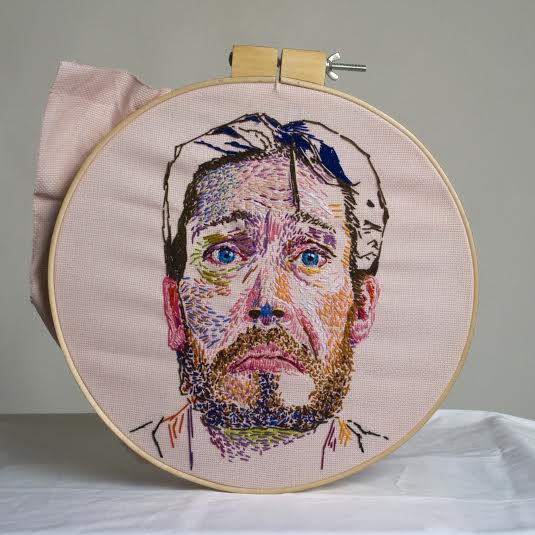The large absence of portraiture in contemporary art can be read as a stance of overreaction. There are, after all, mountains of masters to climb over, from Sargent’s societal faces in the gilded age, to Warhol’s silkscreen prints of famous people. What is unclear is whether there is still something new to be offered in the genre, that speaks either from a different perspective or with a new set of vocabulary, or even better, provides both.
Kim Brewer’s portraiture marries the very focus of contemporary art – material and process – with a close look at societal injustice in the information age. If they have not fully answered the question above, at least her oeuvre in this genre is refreshing and worth our attention.
The first time I saw Kim’s works was at Red Arrow Gallery. Facial features, often depicted partially, are rendered with succinct, intense colors. “The more you walk away, the better they resemble a likeness.” Said Brewer. But the very nature of those pure color patches on a rugged sheet, at close proximity, deconstructs any form that can be perceived as realism.
The artist adopts the ancient paper-making methodology as an integral part of her process. Based on a limited selection of dyes, Brewer dips paper pulps of varied size into the dye, before placing them onto a grid frame, where the paper will form. The picture is created in reverse since the imagery is seen under the opposite side of the grid. That can be challenging — until the moment when the grid frame is flipped over, how exactly the fiber and colors come together cannot be predicted.
Like a fresco painting, the paper surface is bound together through an air-drying process. Yet there is as much control as randomness in it. When the binding process starts, the colors between adjacent pulps interact and overlap, creating haloing subdued borders. “You must work with the flow. Sometimes the harder you want to place facial features at exact locations, the worse it may turn out. You pretty much have only one shot.”

Kim’s subjects are not royalty, celebrities or art patrons. Instead, they are mug shots found online. While their innocence may not be agreed upon among family, friends, media and the public, their faces are petrified as icons of wrongdoing. The chosen portraiture, rarely in details hence staying anonymous, makes my eyes itch for narratives. Though storylines won’t be found, Brewer successfully purveys a sense of distress or fear, through juxtaposition of contrasting colors. Our eyes are inevitably drawn to colors clashing and hovering above a muted background. To our psyche, that incongruency speaks in loud volume of uneasiness of the character.
To some extent, Brewer confronts the very nature of mug shots — While the original photos document what they look, and incarnate individuals perpetually online; Brew frees them from prejudice, by suggesting how they may feel.
The artist is also experimenting with other mediums such as needle works and woven felt. Handcrafts have traditionally been associated with feminine activities, especially in a domestic setting. Brewer nevertheless embraces low art in her artistic pursuit. In her own modest words, she is not a master of these mediums, but she is willing to let each medium throw her into an unknown terrain, in search of her own artistic voice.
By and large, the physicality of all these different material demands a more summarily approach for portraiture. But each has its own unique challenges. Woven felt is layered through labor-intensive stabbing to secure those semi-translucent felt to fabric. Tibetan wool felts have such distinct saturated colors that the outcome of a likeness suggests an almost surrealism palette.
On the other hand, needle work is more like line drawing. It is intriguing to see faces reduced into patterns of short dashes. Still I find an ephemeral beauty from those uneven paper surfaces. The economy of touches through colored paper pulp is exquisite and stimulating. And the process can be extrapolated by visually tracing the ruggedness of paper. In them, there is no over-thinking, just all pure instantaneous acts of faith, in her best capacity to see.


